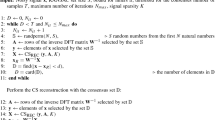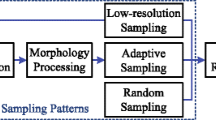Abstract
Image denoising is a vital image processing phase aiming to improve the quality of images and to make them more informative. In this paper, we propose a blind denoising approach for removing the outliers (impulsive disturbances) from digital images, by combining the random sample consensus (RANSAC) and compressive sensing (CS) principles. The proposed approach exploits the fact that images are highly concentrated in the domain of two-dimensional discrete cosine transform (2D-DCT). The sparsity (high concentration) in the transform domain is used in both detection and reconstruction of pixels affected by high disturbances. The image pixels not affected by the noise are found using the RANSAC-based methodology and they are further used as available measurements in the CS reconstruction. The affected pixels are considered unavailable and they are recovered by the CS procedure. The presented approach does not require any disturbance-related assumptions regarding the statistical behavior of the noise or about the range of its values. The theory is verified on examples with 55 images. The comparative analysis against several state-of-the-art methods, done with full-reference and no-reference quality metrics, suggests that the proposed method can be used as an efficient tool for image denoising.





Similar content being viewed by others
References
Aggarwal HK, Majumdar A (2016) Hyperspectral image denoising using spatio-spectral total variation. IEEE Geosci Remote Sens Lett 13 (3):442–446
Arad B, Ben-Shahar O (2016) Sparse Recovery of hyperspectral signal from natural RGB images. In: Leibe B, Matas J, Sebe N, Welling M. (eds) Computer vision – ECCV 2016. ECCV 2016. Lecture notes in computer science, vol 9911. Springer, Cham, pp 19–35
Baraniuk RG (2007) Compressive sensing. IEEE Signal Proc Mag 24(4):118–121
Bartyzel K (2016) Adaptive Kuwahara filter. Signal Imag Video Process 10:663–670
Blumensath T (2011) Sampling and reconstructing signals from a union of linear subspaces. IEEE Trans Inf Theory 57(7):4660–4671
Boufounos P, Jacques L, Krahmer F, Saab R (2015) Quantization and compressive sensing. In: Boche H, Calderbank R, Kutyniok G, Vybíral J (eds) Compressed sensing and its applications. Applied and Numerical Harmonic Analysis, Birkhäuser, Cham, pp 193–237
Brajović M, Stanković I, Daković M, Stanković L (2020) The DCT domain sparsity-assisted detection and recovery of impulsively disturbed samples. Multimed Tools Appl:80. https://doi.org/10.1007/s11042-020-09998-whttps://doi.org/10.1007/s11042-020-09998-w
Brajović M, Stanković I, Daković M, Ioana C, Stanković L Error in the Reconstruction of Nonsparse Images, Mathematical Problems in Engineering, 2018, Article ID 4314527, 10 pages, https://doi.org/10.1155/2018/4314527https://doi.org/10.1155/2018/4314527
Candès EJ, Romberg J, Tao T (2006) Robust uncertainty principles: exact signal reconstruction from highly incomplete frequency information. IEEE Trans Inf Theor 52(2):489–509
Candès EJ, Tao T (2005) Decoding by linear programming. IEEE Trans Inf Theory 52(12):4203–4215
Carrillo RE, Barner KE, Aysal TC (2010) Robust sampling and reconstruction methods for sparse signals in the presence of impulsive noise. IEEE J Select Topic Signal Process 4(2):392–408
Caselles V, Chambolle A, Novaga M. (2011) Total variation in imaging. Handbook Math Method Imag, Springer
Cetin AE, Tofighi M (2015) Projection-based Wavelet denoising. IEEE Signal Proc Mag 32(5):120–124
Chai X, Zheng X, Gan Z, Han D, Yiran C (2018) An image encryption algorithm based on chaotic system and compressive sensing. Signal Process 148:124–144
Chambolle A, Pock T (2011) A first-order primal-dual algorithm for convex problems with applications to imaging. J Math Imag Vis 40:120–145
Dabov K, Foi A, Katkovnik V, Egiazarian K (2007) Image denoising by sparse 3D transform-domain collaborative filtering. IEEE Trans Im Proc 16(8):2080–2095
Daubechies I, Defrise M, De Mol C (2004) An iterative thresholding algorithm for linear inverse problems with a sparsity constraint. Commun Pur Appl Math 57(11):1413–1457
Davis G, Mallat S, Avellaneda M (1997) Adaptive greedy approximations. Construct Approx 13(1):57–98
Djurović I (2017) Combination Of the adaptive Kuwahara and BM3d filters for filtering mixed Gaussian and impulsive noise. Sig Im and Video Proc 11:753–760
Djurović I (2017) QML-RANSAC: PPS and FM signals estimation in heavy noise environments. Signal Process 130:142–151
Djurović I (2018) QML-RANSAC If Estimator for overlapping multicomponent signals in the TF plane. IEEE Signal Process Lett 25(3):447–451
Donoho DL (2006) Compressed sensing. IEEE Trans Inf Theory 52 (4):1289–1306
Donoho DL, Elad M, Temlyakov VN (2006) Stable recovery of sparse overcomplete representations in the presence of noise. IEEE Trans Inf Theory 52(1):6–18
Elad M (2010) Sparse and redundant representations: from theory to applications in signal and image processing. Springer, New York
Fadili MJ, Starck JL, Murtagh F (2009) Inpainting and zooming using sparse representations. Comput J 52(1):64–79
Figueiredo M, Bioucas-Dias J, Oliveira JP, Nowak RD (2006) On total-variation denoising: a new majorization-minimization algorithm and an experimental comparison with wavelet denoising. IEEE Int Conference Image Process (ICIP):2633–2636
Figueiredo MA, Nowak RD, Wright SJ (2007) Gradient projection for sparse reconstruction: Application to compressed sensing and other inverse problems. IEEE J Select Topic Signal Process 1(4):586–597
Image database (2021) Computer Vision group. University of Granada. http://decsai.ugr.es/cvg/CG/base.htm last opened
Jiang J, Zhang L, Yang J (2014) Mixed Noise removal by weighted encoding with sparse nonlocal regularization. IEEE Trans Image Process 23(6):2651–2662
Lebrun M (2012) An analysis and implementation of the BM3d image denoising method image processing on line
Liao X, Li K, Zhu X, Liu KJ (2020) Robust detection of image operator chain with two-stream convolutional neural network. IEEE J Select Topic Signal Process 14(5):955–968
Liao X, Yin J, Chen M, Qin Z (2020) Adaptive Payload distribution in multiple images steganography based on image texture features. IEEE transactions on dependable and secure computing (early access)
Liao X, Yu Y, Li Z, Qin Z (2020) A New payload partition strategy in color image steganography. IEEE Trans Circuits Syst Video Technol 30 (3):685–696
Ma H, Nie Y Mixed Noise Removal Algorithm Combining Adaptive Directional Weighted Mean Filter and Improved Adaptive Anisotropic Diffusion Model, Mathematical Problems in Engineering, 2018, Article ID 6492696
Manolis L (2021) TV-L1 Image Denoising Algorithm (https://www.mathworks.com/matlabcentral/fileexchange/57604-tv-l1-image-denoising-algorithm), MATLAB Central File Exchange. Retrieved January 25, 2021
Mittal A, Soundararajan R, Bovik AC (2013) Making A “Completely blind” image quality analyzer. IEEE Signal Process Lett 20(3):209–212
Needell D, Tropp JA (2009) CosaMP: iterative signal recovery from incomplete and inaccurate samples. App Comp Harm An 26(3):301–321
Ramadan Z (2012) Efficient Restoration method for images corrupted with impulse noise. Circ Syst Signal Process 31(4):1397–1406
Rani M, Dhok SB, Deschmukh RB (2018) A Systematic review of compressive sensing: concepts. Implement Appl IEEE Access 6:4875–4894
Shah A, Bangash JI, Khan AW, Ahmed I, et. al (2020) Comparative Analysis of median filter and its variants for removal of impulse noise from gray scale images. Journal of King Saud University - Computer and Information Sciences
Stanković I, Brajović M, Daković M, Ioana C, Stanković L (2020) Quantization In compressive sensing: a signal processing approach. IEEE Access 8:50611–50625
Stanković I, Brajović M, Daković M, Ioana C, Stanković L (2020) Bit-depth quantization and reconstruction error in images. Sig Image Video Process 14(8):1545–1553
Stanković L, Brajović M, Stanković I, Lerga J, Daković M (2021) RANSAC-based signal denoising using compressive sensing. Circ Syst Signal Process 40. https://doi.org/10.1007/s00034-021-01654-4
Stanković I, Djurović I, Daković M (2018) Adaptive average BM3d filter for reconstruction of images with combined noise. 7th MECO 2018, Budva, Montenegro
Stanković I, Orović I, Daković M, Stanković S (2018) Denoising Of sparse images in impulsive disturbance environment. Multimed Tools Appl 77(5):5885–5905
Stanković S, Orović I, Sejdić E (2012) Multimedia signals and systems. Springer, New York
Stanković L, Sejdić E, Stanković S, Daković M, Orović I (2019) A tutorial on sparse signal reconstruction and its applications in signal processing. Circ Syst Signal Process 38:1206–1263
Stanković L, Stanković S, Amin MG (2014) Missing samples analysis insignals for applications to L-estimation and compressive sensing. Sig Proc 94:401–408
Stanković L, Stanković S, Orović I, Amin MG (2013) Robust time-frequency analysis based on the L-estimation and compressive sensing. IEEE Signal Process Lett 20(5):499–502
Studer C, Kuppinger P, Pope G, Bolcskei H (2012) Recovery of sparsely corrupted signals. IEEE Trans Inf Theory 58(5):3115–3130
Turlach BA (2005) On algorithms for solving least squares problems under an L1 penalty or an L1 constraint
Wang Z, Bovik AC, Sheikh HR, Simoncelli EP (2004) Image quality assessment: from error visibility to structural similarity. IEEE Trans Image Proc 13(4):600–612
Wang Z, Simoncelli EP, Bovik ACAC (2003) Multiscale structural similarity for image quality assessment. In: Proceedings of the 37th Asilomar Conference on Signals, Systems & Computers, 2003, 1398–1402. Pacific Grove, CA USA: IEEE, DOI https://doi.org/10.1109/ACSSC.2003.1292216, (to appear in print)
Wright SJ (1990) Implementing proximal point methods for linear programming. J Optim Theory Appl 65(3):531–554
Yang Y, Sun J, Li H, Xu Z (2020) ADMM-CSNEt: a deep learning approach for image compressive sensing. IEEE Trans Pattern Anal Mach Intell 42 (3):521–538
Zhang B, Zhu Z, Wang S (2016) A Simple primal-dual method for total variation image restoration. J Vis Commun Image Represent 38(C):814–823
Zhuang L, Ng MK (2020) Hyperspectral Mixed noise removal by L1-Norm-based subspace representation. IEEE J Selected Topic Appl Earth Observ Remote Sens 13:1143–1157
Author information
Authors and Affiliations
Corresponding author
Ethics declarations
The authors have no relevant financial or non-financial interests to disclose.
Additional information
Publisher’s note
Springer Nature remains neutral with regard to jurisdictional claims in published maps and institutional affiliations.
Rights and permissions
About this article
Cite this article
Stanković, I., Brajović, M., Lerga, J. et al. Image denoising using RANSAC and compressive sensing. Multimed Tools Appl 81, 44311–44333 (2022). https://doi.org/10.1007/s11042-022-13192-5
Received:
Revised:
Accepted:
Published:
Issue Date:
DOI: https://doi.org/10.1007/s11042-022-13192-5




